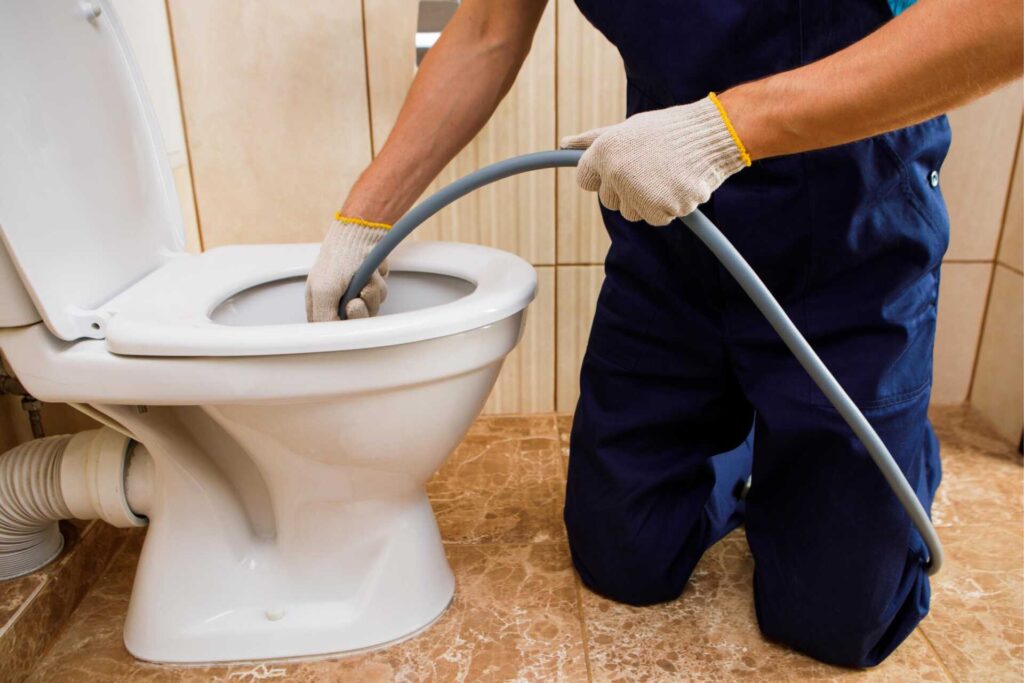
Contents
When faced with an unfortunate plumbing mishap, it’s essential to tackle the situation with a methodical approach. Understanding the steps for effective sewage backup cleanup can greatly reduce health risks and property damage. From identifying the source to implementing preventive measures, each step plays a critical role in restoring your space. Let’s explore the necessary tips that will guide you through this process, ensuring you’re well-equipped to handle any unexpected challenges that may arise.
Key Takeaways
- Identify the source of the sewage backup quickly to minimize health risks and damage.
- Ensure safety by wearing appropriate PPE and ventilating the area before cleanup.
- Remove contaminated water promptly using pumps or wet vacs, disposing of it according to local regulations.
- Thoroughly clean and disinfect affected areas with effective cleaning supplies to prevent contamination.
- Educate your family on responsible waste disposal to prevent future plumbing issues.
Identify the Source of the Backup
When you experience a sewage backup, the first step is to identify the source of the problem, as this will determine the appropriate cleanup strategy. Common sewage causes include clogged pipes, tree root intrusions, or municipal system failures.
You’ll want to look for backup signs like gurgling drains, slow drainage, or unpleasant odors. Start by checking the affected areas, such as sinks, toilets, and basements. If you notice multiple fixtures backing up simultaneously, it’s often indicative of a main line issue.
Use a flashlight to examine visible plumbing and search for any blockages or damage. If you’re comfortable, remove any accessible debris. However, if the source isn’t clear or if you suspect a major failure, it’s best to consult a professional.
Identifying the cause promptly helps in effective cleanup and minimizes potential health risks associated with sewage exposure.
Ensure Safety Precautions
How can you ensure your safety during a sewage backup cleanup? First, equip yourself with proper personal protective equipment (PPE). This includes gloves, masks, goggles, and waterproof boots to shield against harmful pathogens.
Always ascertain that you’re wearing clothing that covers your skin, minimizing exposure to contaminants.
Next, keep emergency contacts handy. This includes local health authorities, professional cleaners, and your insurance provider. Should an emergency arise, having these contacts accessible ensures swift action.
Before starting, ventilate the area by opening windows and doors. This helps disperse any harmful odors and gases.
Avoid working alone; having someone nearby can provide assistance if something goes wrong.
Lastly, ascertain you know the location of your shut-off valves for water and electricity. This precaution prevents further hazards during the cleanup.
Remove Contaminated Water
Begin by evaluating the extent of the contaminated water before proceeding with removal. Analyzing the situation helps you determine the best approach for effective water extraction, especially if flood damage has occurred.
- Use a submersible pump for large volumes of water.
- Employ wet vacs to tackle smaller, more contained areas.
- Confirm proper disposal of contaminated water following local regulations.
- Wear appropriate personal protective equipment (PPE) throughout the process.
Once you’ve evaluated the contamination level, act swiftly to remove the water. The longer it stays, the more damage it can cause to your property.
Clean and Disinfect Affected Areas
Before you start cleaning, prioritize safety by wearing gloves, masks, and protective eyewear.
Use appropriate cleaning supplies that are effective against pathogens to ensure thorough disinfection of all affected surfaces.
Finally, make certain to dry the areas completely to prevent mold growth and further contamination.
Safety Precautions First
While dealing with a sewage backup, it’s vital to prioritize safety as you clean and disinfect affected areas. Start by wearing personal protective equipment (PPE) like gloves, masks, and goggles to minimize health risks. Make sure you have a plan in place to contact emergency services if the situation escalates.
Here are some important safety precautions to follow:
- Seal off the affected area to prevent contamination spread.
- Keep children and pets away from the cleanup zone.
- Avoid direct contact with sewage; use tools for removal.
- Have emergency contacts ready for professional help if needed.
Taking these steps protects you and fosters a communal sense of responsibility in maintaining a safe environment for everyone.
Use Appropriate Cleaning Supplies
Effective cleanup after a sewage backup requires the right cleaning supplies to ensure thorough disinfection and sanitation. You need effective cleaning agents that can tackle harmful pathogens while ensuring safety.
| Cleaning Supplies | Purpose |
|---|---|
| Disinfectants | Kill bacteria and viruses |
| Heavy-duty gloves | Protect your hands |
| Mops and buckets | Remove contaminated water |
| Rags or sponges | Wipe down surfaces |
Using appropriate sanitation techniques is essential. Start by removing debris and contaminated materials, then apply disinfectants to surfaces. Allow adequate contact time for cleaning agents to work effectively. Following these steps makes certain you maintain a safe environment for yourself and your loved ones.
Thorough Drying Process
A thorough drying process is essential after a sewage backup to prevent mold growth and further contamination.
You need to implement effective moisture control and drying techniques to ensure that all affected areas are completely dry.
Use high-powered fans to circulate air and speed up evaporation.
Employ dehumidifiers to reduce humidity levels quickly.
Remove saturated materials, such as carpets or drywall, that can retain moisture.
Regularly check moisture levels with a hygrometer to monitor progress.
Dry Out the Space Thoroughly
After cleaning and disinfecting the affected areas, your next step is to dry out the space thoroughly.
Start by removing any standing water, as this minimizes moisture that can lead to mold growth.
Increase air circulation by opening windows and using fans to expedite the drying process.
Remove Standing Water
Removing standing water promptly is vital to prevent further damage and health risks. You must act quickly to ensure effective water removal and protect your home.
Here are some critical steps to follow:
Use a wet/dry vacuum to extract standing water efficiently.
Wear protective gear like gloves and masks to safeguard against contaminants.
Check for hidden moisture in walls and floors to avoid mold growth.
Dispose of contaminated materials properly to maintain a safe environment.
Increase Air Circulation
To effectively dry out the space after a sewage backup, increasing air circulation is essential. Good air quality is vital for preventing mold growth and lingering odors.
Start by opening windows and doors to encourage cross-ventilation. Use fans to direct airflow throughout the room, ensuring every corner receives adequate ventilation.
If possible, employ dehumidifiers to extract moisture from the air, further enhancing the drying process. Consider using ventilation methods like exhaust fans in areas prone to dampness.
This combination of strategies will help expedite drying and maintain a healthier environment.
Check for Structural Damage
While evaluating the aftermath of a sewage backup, it’s vital to check for structural damage to your property.
Begin with a detailed damage assessment to ensure your home’s structural integrity remains intact. Look for signs that could indicate hidden issues that might compromise safety.
- Inspect walls for cracks or warping.
- Check floors for sagging or soft spots.
- Examine the foundation for any signs of water infiltration.
- Assess ceilings for discoloration or drooping.
These indicators can help you identify potential risks. If you notice any of these issues, it’s important to consult a professional immediately.
They can provide a thorough evaluation and recommend necessary repairs. Prioritizing your home’s structural integrity keeps you safe and preserves the value of your property.
Prevent Future Sewage Backups
Taking proactive steps can greatly reduce the risk of future sewage backups in your home. Start with regular drain maintenance; clearing debris and grease buildup keeps your plumbing flowing smoothly.
Invest in professional plumbing inspections at least once a year. These inspections can identify potential issues like tree root intrusion or pipe deterioration before they escalate.
Moreover, avoid flushing non-biodegradable items down the toilet or pouring fats, oils, and grease down the sink. Educate your family on proper disposal methods to create a collective responsibility for plumbing health.
Additionally, consider installing a backwater valve to prevent sewage from flowing back into your home during heavy rainfall or system failures.
Recap
By following these essential tips for sewage backup cleanup, you can restore your space and peace of mind, much like a phoenix rising from the ashes. Remember, swift action and thoroughness are your allies in combatting the aftermath of contamination. As you protect your home from future incidents, think of it as fortifying a castle against invaders. Stay vigilant, educate your family, and implement preventive measures to ensure your home remains a safe haven.
Recent Posts
Sewage Backup Cleanup: FAQs for Homeowners
When faced with a sewage backup, you might wonder how such an issue could happen
Effective Sewage Backup Cleanup for Homes
When a sewage backup occurs in your home, acting quickly is fundamental. You need to
Why Choose 24/7 Flood Damage Cleanup Experts?
When flood damage strikes, you need immediate help from experts who understand the urgency of
